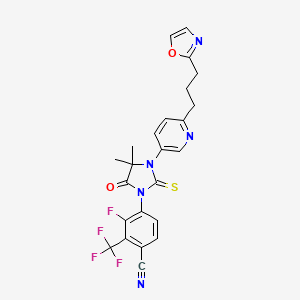



1. 4-(4,4-dimethyl-3-(6-(3-(2-oxazolyl)propyl)-3-pyridinyl)-5-oxo-2-thioxo-1-imidazolidinyl)-3-fluoro-2-(trifluoromethyl)benzonitrile
2. Gt 0918
3. Gt-0918
4. Gt0918
1. 1398046-21-3
2. Pruxelutamide
3. Gt-0918
4. Proxalutamide [who-dd]
5. Qx6o64gp40
6. 4-(4,4-dimethyl-3-(6-(3-(2-oxazolyl)propyl)-3-pyridinyl)-5-oxo-2-thioxo-1-imidazolidinyl)-3-fluoro-2-(trifluoromethyl)-benzonitrile
7. 4-[4,4-dimethyl-3-[6-[3-(1,3-oxazol-2-yl)propyl]pyridin-3-yl]-5-oxo-2-sulfanylideneimidazolidin-1-yl]-3-fluoro-2-(trifluoromethyl)benzonitrile
8. 4-(4,4-dimethyl-3-(6-(3-(oxazol-2-yl)propyl)pyridin-3-yl)-5-oxo-2-thioxoimidazolidin-1-yl)-3-fluoro-2-(trifluoromethyl)benzonitrile
9. Unii-qx6o64gp40
10. Pruxelutamide [inn]
11. Chembl4594417
12. Schembl12494226
13. Gtpl11992
14. Dtxsid901102678
15. Ex-a5434
16. Gt0918
17. At29744
18. Sb17303
19. Hy-103184
20. Cs-0025229
21. Q27287540
22. 4-(4,4-dimethyl-3-(6-(3-(oxazol-2-yl)propyl)pyridin-3-yl)-5-oxo-2-thioxoimidazolidin-1-yl)-3-fluoro-2-(trifluoromethyl) Benzonitrile
| Molecular Weight | 517.5 g/mol |
|---|---|
| Molecular Formula | C24H19F4N5O2S |
| XLogP3 | 4.3 |
| Hydrogen Bond Donor Count | 0 |
| Hydrogen Bond Acceptor Count | 10 |
| Rotatable Bond Count | 6 |
| Exact Mass | 517.11955869 g/mol |
| Monoisotopic Mass | 517.11955869 g/mol |
| Topological Polar Surface Area | 118 Ų |
| Heavy Atom Count | 36 |
| Formal Charge | 0 |
| Complexity | 894 |
| Isotope Atom Count | 0 |
| Defined Atom Stereocenter Count | 0 |
| Undefined Atom Stereocenter Count | 0 |
| Defined Bond Stereocenter Count | 0 |
| Undefined Bond Stereocenter Count | 0 |
| Covalently Bonded Unit Count | 1 |
Proxalutamide is an antagonist at the androgen receptor which leads to inhibition of androgen-induced receptor activation and results in formation of inactive complexes that are not able to translocate to the nucleus. It also induces androgen receptor downregulation, furthering adrogen-induced receptor activation. This drug is being investigated for its potential antineoplastic activity and is being investigated specifically against prostate cancer and COVID-19.